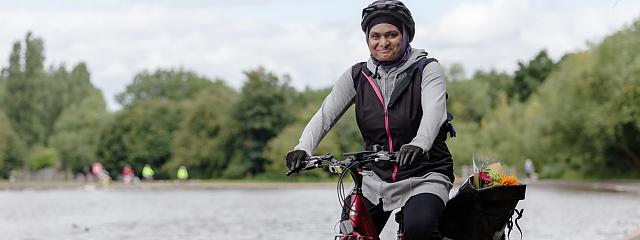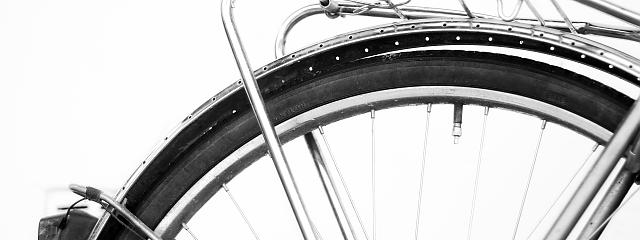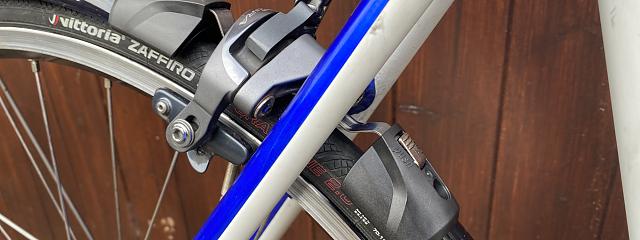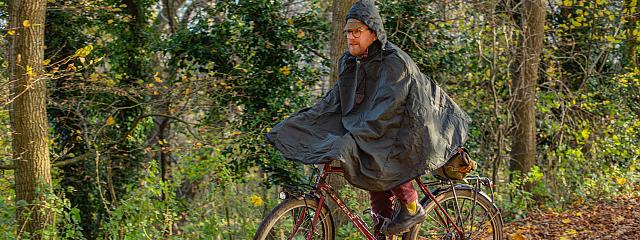
How to survive riding in the rain
How to survive riding in the rain
With the downpours we Brits regularly have to put up with, many people are put off cycling to work. But it is possible to commute by bike and survive all year round with just a little bit of preparation.
“Heavy rain is expected causing hazardous driving conditions” are the words of the weather forecaster that all cyclists dread. “Never mind drivers, what about us!?” you want to yell at the radio as you look out of the window at the threatening clouds.
Should you abandon the bike for a change and tramp miserably to the bus stop or grab the car keys and resign yourself to a long, slow journey to work in the inevitable queues of traffic? Or could you take the third option and just cycle anyway? If you don’t know, read this handy guide and it could help you make your mind up.
Why cycle in the rain?
- First of all, it doesn’t rain THAT much in this country (with notable exceptions of course!).
- Secondly, often the heavy downpours turn out to be just showers – unlucky if you catch one, but they are usually shortlived.
- You can always dry out when you get to work, assuming you work indoors, and you’ll get wet anyway if you don’t.
- Will you stay 100% dry waiting at the bus stop for a bus that might never come? Or on the station platform? Or getting to and from your car?
- You’ll appreciate the cosy warmth of your air-conditioned office far more, knowing that you’ve battled the elements to get there - and you can spend the money saved on a takeaway coffee to enjoy at your desk
Now for the hows:
- It goes without saying that decent waterproof layers will help keep you dry and comfortable, but don't pile on too many - unless it's Arctic conditions outside - or you'll end up as wet from sweat as rain;
- Gloves and a peaked hat are also essential, unless it’s warm, summer rain – a baseball cap, a cycling cap or any hat with a peak will keep your head dry and the water out of your eyes;
- Waterproof panniers such as Ortliebs will keep your change of clothes dry – at the very least wrap them in a carrier bag or two;
- Mudguards may not be the hippest of cycling accessories but then neither is a streak of mud up your back or in the eyes of the person following you;
- Many people are lucky enough to have showers and drying rooms at work – if your workplace doesn’t have any, consider forming a Bicycle User Group to lobby for them;
- Take a change of dry clothes - not only will you stay comfortable at your desk, you'll not have to change into wet clothing for the journey home.













Comments
Puddles
"riding through puddles is one of life’s most underrated pleasures"
Also totally stupid and dangerous as often there will be a nasty pothole hiding under that puddle. Ride through it and you could be sprawled across the road in front of that car ...
Do the authors of these article actually cycle on UK roads?
I was about to make a very
I was about to make a very similar comment. Riding through puddles USED TO BE a pleasure- nowadays you dare not risk it.
puddles NOOO, and what about non communting rides
100% agree with others about puddles - DO NOT ride through a puddle unless either you can't avoid it or you know that stretch of road really well and are sure there is nothing nasty lurking under the surface.
A very stupid remark in the article - please delete it.
The piece seems to assume that the only people who ride in the rain are commuters - actually leisure, touring and sportive riders are probably more likely to be caught out in the rain.
For touring waterproof panniers or at least two layers of plastic bags around everything in the panniers is essential - it is amazing how far water will penetrate and there's nothing worse than finally pulling out your dry clothes to find large damp patches where your plastic bag had a pinhole in it.
Personally I like an old fashioned cape for rain - yes it increases windage massively but if it has tapes securing it to the handlebars and back of the saddle it keeps you good and dry above the legs and is airy and light.
Waterproof socks are a godsend - they don't necessarily keep your feet dry but they act like wet-boots filling with water that has trickled down your legs and keep your tootsies nice and warm.
In summer the best solution to a rain spell is often simply to take your top off - amazingly it turns out skin is waterproof and drip dries quite quickly. A wet t-shirt will soon have you shivering with cold.
RogerCO
Riding in heavy rain
My wife and I have just returned from a holiday in Germany (Black Forest mainly) and France (Alsace). We had our Bromptons (for was of train travel) and planned short easy rides with little challenge (some health problems). In the Black Forest we had to contend with very heavy rain. In addition on one day there were three other challenges: unseasonably low temperatures, very strong headwinds and rather more climbing than is comfortable on a Brompton with its high gearing. Because of limited luggage-carrying capacity we did not really have enough clothing for these conditions, and in future I shall think more carefully about how to remain warm and dry over several hours.
My observation is that
My observation is that generally the forecasts are very pessimistic.
Riding through puddles is
Riding through puddles is like betting in a casino where the odds are always stacked against you. Five punctures in September are testament to the lovely, ubiquitous potholes we now have to endure.
How to survive riding in the rain
1. I'm not sure about the advice to wear a baseball cap. I used to wear one under my helmet until a friend warned me that the helmet could slip about on my head in the event of a knock and fail to protect me adequately. I now have a helmet with a short peak.
2. For the last five years I have been using Rainlegs (https://www.rainlegs.com/en/home) which go over the top of the leg and fold just over the knee, leaving the rest of the leg unprotected. They are small enough to roll up and put in my cycle jacket pocket, so I've always got them to hand. It's the top of the leg that gets the worst of the wet, and I'm not riding with a sauna beneath my waist. My long trousers are quick-dry hiking trousers - if they are absolutely saturated (which might happen in a heavy downpour, or after being splashed) I can unzip the lower legs, put them on a radiator, and they are dry in about ten minutes! I ride about town in the worst of the heavy rain. The only thing which stops me (at the age of 70) is ice.
Riding in the wet AND dark is not so easy...
When the road surface is wet it reflects light: your light away from you into the distance and that of oncoming cars straight into your face. I realise that UK roads have such rough surfaces that they may not reflect that much, but it is probably enough seriously to reduce the effectiveness of your bike lighting. To see well you need as much power as you can get. A peaked cap or helmet can help to shade your eyes from direct light.
Here in Germany on my way to work I cycle along a fairly smooth cycle path on the "wrong" side of the road, so I get a lot of light from cars. It is almost impossible to see anything. Fortunately I know there are no potholes.